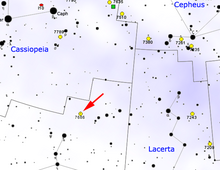NGC 7686 is a moderately-sized open cluster in the constellation Andromeda, containing about 80 stars.[2] At magnitude 5.6, it is an easy target for binoculars and small telescopes.[3]
| NGC 7686 | |
|---|---|
 NGC 7686 (taken from Stellarium) Credit: Roberto Mura | |
| Observation data (J2000 epoch) | |
| Right ascension | 23h 29m 41.(3)s[1] |
| Declination | +49° 10′ 1(2)″[1] |
| Apparent magnitude (V) | 5.6[2] |
| Apparent dimensions (V) | 15′[2] |
| Physical characteristics | |
| Other designations | Cr 456, C2327+488, Herschel VIII69[2] |
| Associations | |
| Constellation | Andromeda |
According to Johnson et al. (1961), the "color-magnitude diagram shows merely a uniform scatter with no significant tendency to show a cluster main sequence". They conclude that this is not actually a star cluster.[4]

References
edit- ^ a b Kharchenko, N. V.; et al. (2013), "Global survey of star clusters in the Milky Way. II. The catalogue of basic parameters", Astronomy & Astrophysics, 558: A53, arXiv:1308.5822, Bibcode:2013A&A...558A..53K, doi:10.1051/0004-6361/201322302, S2CID 118548517.
- ^ a b c d Inglis, Mike (2013), Observer's Guide to Star Clusters, Springer Science & Business Media, p. 14, Bibcode:2013ogsc.book.....I, ISBN 978-1461475675
- ^ Dunlop, Storm (2005), Atlas of the Night Sky, Collins, ISBN 978-0-00-717223-8.
- ^ Johnson, H. L.; et al. (1961), "Galactic clusters as indicators of stellar evolution and galactic structure", Bulletin of the Lowell Observatory, 5 (8): 133–147, Bibcode:1961LowOB...5..133J.
External links
edit- Media related to NGC 7686 at Wikimedia Commons
- http://seds.org
- NGC 7686 on WikiSky: DSS2, SDSS, GALEX, IRAS, Hydrogen α, X-Ray, Astrophoto, Sky Map, Articles and images